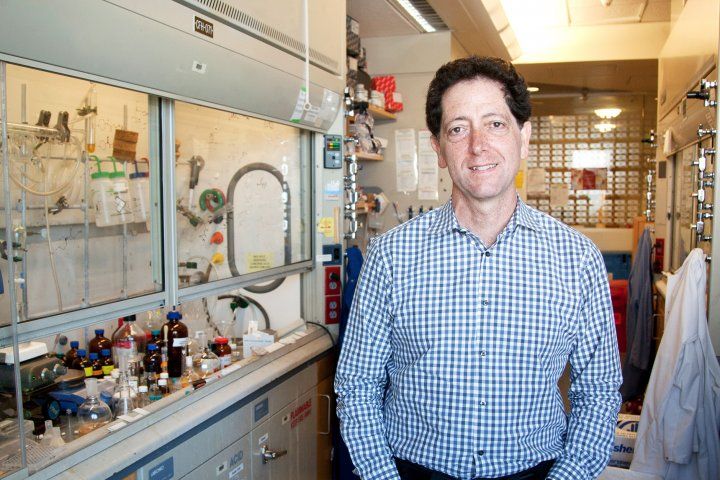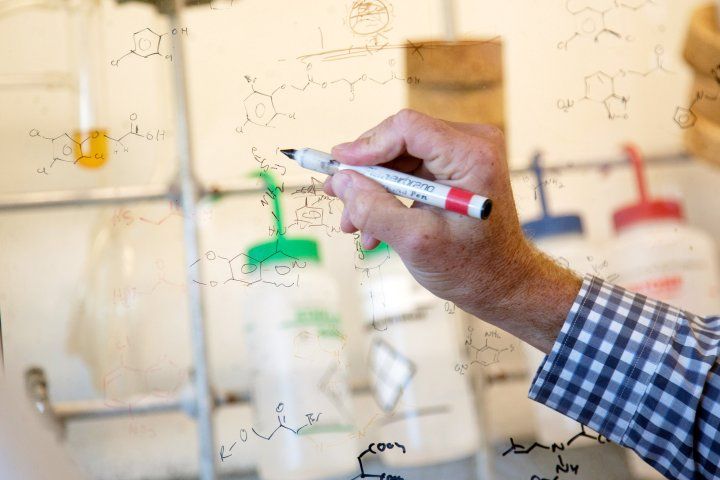Targeted Therapy for ‘Undruggable’ Lung Cancer Stems from Decades of UCSF Research

In this image from a genetically engineered mouse model, lung cancer driven by the Kras oncogene shows up in purple. As a key driver in many types of cancer, the Kras gene makes a promising target for new cancer therapies. Image by National Institutes of Health
Over the past two decades, targeted cancer therapies have changed the prognosis for thousands of patients. By targeting the specific genetic mutation behind a patient’s cancer, these therapies have enabled increasing numbers of patients to experience fewer toxic side effects and, often, live free of disease following their treatment.
But until May 28, 2021, when the U.S. Food and Drug Administration approved sotorasib for non-small cell lung cancer, there had been no targeted therapy available for people affected by the most common gene-related driver of tumor growth, the protein KRAS.
This long-delayed treatment milestone might not have happened at all without seminal accomplishments by UC San Francisco chemist and Howard Hughes Medical Institute Investigator, Kevan Shokat, PhD, who succeeded in revitalizing a holy-grail-like quest after almost all others had given up.
The Biggest Player in the Deadliest Cancers
Scientists have known since the 1970s – with the Nobel-prize winning discovery of “oncogenes” by UCSF professors J. Michael Bishop, MD, and Harold Varmus, MD – that normal genes within a cell can mutate, causing the cell to turn against the body and develop into life-threatening tumors.
This discovery set off a successful hunt for more cancer-causing mutations – of which more than 100 are now known – as well as efforts to design new cancer therapies specific to those genes. In 1998, the breast cancer drug Herceptin became the first therapy targeted to a specific oncogene, followed by a rising number of oncogene-targeted drugs since then.
Yet KRAS mutations – which are found in about one-quarter of solid tumors and are the leading cause of lung cancer – have managed to elude those attempts.
Oncogenic KRAS was discovered four decades ago and was almost immediately recognized as a significant discovery. But after long and, ultimately, fruitless rounds of drug development, the protein encoded by the oncogene was deemed “undruggable” – a “Death Star” of cancer – and these efforts were abandoned.
KRAS mutations in cancer have remained associated with poor outcomes and failures to respond to other treatments. In lung cancer, which has long been the leading cause of cancer mortality, KRAS mutations drive the growth of about 25,000 new lung cancers each year.
Shokat Finds Hidden KRAS Pocket
The fundamental purpose of the KRAS protein is to carry growth signals from outside the cell to the cell’s nucleus. There, it activates additional biochemical pathways downstream that transmit growth signals within the cell. Cancer-associated mutations cause KRAS to spend most of its time in the “on” position, constantly activating further growth.

Kevan Shokat in his lab in 2014. Photo by Cindy Chew
Unlike more typical oncogenic enzymes, KRAS does not have an easily accessible pocket on its surface where a drug could lodge and block access by the natural KRAS activator, a tiny molecule called GTP. In previous research, KRAS resisted efforts to dislodge GTP from the active site and engage with any small-molecule drug. There also appeared to be no other access point where a drug might attach to disable the protein.
Shokat, a professor in the Department of Cellular and Molecular Pharmacology whose research focuses on small-molecule drug discovery, had already been looking at molecular pathways that include enzymes such as GTPases. He also was specifically interested in developing molecular tools to create binding pockets on proteins that don’t exist naturally. And, he already had been focused on discovering clinically exploitable aspects of proteins in cancer, and had made previous cancer-related discoveries that eventually led to successful drug development. KRAS was the perfect puzzle.
In 1999, Shokat’s UCSF colleague Frank McCormick, PhD, FRS, who was well versed on prior industry failures to stymie KRAS in cancer, persuaded Shokat to give it a go.
Launching a project that lasted several years, Shokat decided to focus on a known but often overlooked “single-point” mutation to KRAS, in which the amino acid cysteine replaced what normally would be the amino acid glycine.
Graduate student Jon Ostrem used a high throughput drug-screening approach developed by professor Jim Wells, PhD, to search for small molecules that might chemically bond to the cysteine mutation and also affect KRAS activity. Once he succeeded, Ulf Peters, PhD, a postdoctoral fellow, used a high-resolution technique called x-crystallography to determine the structure of the drug bound protein.

Color illustration of the KRAS protein. Image by NIH
That revealed the location and shape of a previously unknown, accessible pocket on the surface of KRAS, entirely distinct from the GTP-binding site that had been an earlier focus of drug development. The small molecules that bonded to the mutant cysteine froze the protein in an inactive state, which suggested to Shokat that drug development was possible.
Until then, the mutated KRAS was believed to almost always be in the activated state. But by 2016, scientists from Wellspring Biosciences, a company that Shokat and McCormick co-founded, had discovered that even when mutated, the enzyme cycles between the active and inactive states, and company scientists successfully used a drug prototype to kill tumor cells in living animals.
Wellspring formed a partnership with Janssen Biotech, a subsidiary of Johnson & Johnson, to further develop drugs to target this distinctive KRAS mutation. Then, several other pharmaceutical companies re-entered the field. The race was on once again.
“If we hadn’t started a company and really worked with them to make those important advancements, I don’t know if other companies would have believed enough in how the drug works to jump back in with their own drug development programs,” Shokat says.
KRAS Drugs Approach the Finish Line
The first company to the tape was Amgen, which won accelerated approval in May from the FDA for its drug, Lumakras (sotorasib). Amgen’s “CodeBreaK 100” clinical study found that the drug shrank tumors in 37 percent of patients with advanced cancers who already had been treated with one or more systemic drugs – chemotherapy, immunotherapy or targeted therapy – with a median response of 11 months. The drug’s approval for this group of patients is expected to immediately change clinical practice.
Based on the properties of the drug Shokat first envisioned long ago, he is optimistic that greater strides for KRAS inhibitors are in the works. Unlike most targeted therapies, the new drugs targeting the cysteine point mutation do not affect the KRAS protein found in normal cells. This feature is likely to reduce the side-effects of drug combinations that aim to deliver a knockout punch before a tumor develops drug resistance, he says.

Photo by Cindy Chew
“To go from no response in these patients to 37 percent response with a single drug is encouraging,” he said. “But I think combination therapies will be much better.”
There’s another advantage of such a strongly attached drug, Shokat says.
“The irreversible binding of the drug to the mutant cysteine means that the drug essentially becomes part of the protein,” he explained, describing a new collaboration with professor Charles Craik. “That drug-bound protein can be recognized as a distinct, foreign target by the immune system, boosting the likelihood that adding a targeted immunotherapy to treatment may improve outcomes for patients.”
About 13 percent of non-small cell lung cancers (NSCLC) have the KRAS cysteine point mutation. In addition, at the exact same location in the protein, called codon 12, and in about the same number of cases, KRAS mutates to a different amino acid, to either aspartic acid or valine.
Among colon cancers, about 40 percent have KRAS mutations, a majority occurring at codon 12 with aspartic acid. Most strikingly, about 90 percent of pancreatic cancers – also an extremely lethal disease – are attributed to KRAS mutation, and valine or aspartic acid mutations at codon 12 account for about 75 percent of cases.
“I think it won’t be too long before there are drugs targeting these other codon 12 mutations in clinical trials,” Shokat says. “That will be next, big, exciting step in drugging KRAS. Now that we have a good handle on it, there will be no more letting go.”